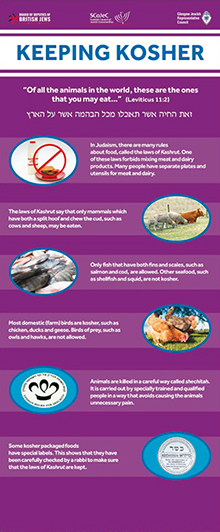|
|
Judaism and the Jewish Community
Daily Life:
Keeping Kosher |
| |
|
| |
|
| |
| |
|
Additional Information |
● |
The adjective kasher or kosher means ‘fit for purpose according to Jewish law’. The noun from kosher is kashrut, which usually refers to the Jewish dietary laws, but these terms are also used in other contexts too, such as about religious artefacts. For example, a Torah scroll or mezuzah with even one damaged letter would not be kosher. |
● |
The main rules of kashrut are: |

|
Animals are only kosher to eat if they have the characteristics listed in the Torah – cloven hooves and chew the cud – so for example beef and lamb, but not pork, horse, or camels. |

|
Bird species that are kosher are listed in the Torah but it is difficult to identify them in modern terms, so only those recognised by tradition are eaten. Generally birds of prey are not kosher, and domestic fowl such as chicken, duck, and turkey are kosher. |

|
Fish are only kosher to eat if they have fins and scales, so for example salmon, haddock, and herring, but not eels. |

|
Shellfish and insects are never kosher. |

|
Milk, eggs, and other animal products are only kosher if they come from a kosher animal. |
● |
The laws of kashrut teach compassion, and concern for animal welfare. These include shechitah – using an extremely sharp knife to kill an animal as quickly as possible in order not to cause it pain. People who carry out shechitah have to undergo a lot of training and follow very strict regulations. |
● |
Kosher butchers, bakers, and restaurants have prominently displayed certificates confirming that their businesses follow all the laws of kashrut, and many ordinary commercial food products have symbols on their packaging to indicate that the manufacturing process has been inspected and found to comply with kosher standards. |
● |
Some food products do not have a symbol on their packaging, but are listed in special guidebooks, apps, and websites, so that Jewish people can check which products are kosher. One example is the kosher search app provided by the kashrut department of the London Bet Din (Rabbinical Court). |
|
| |

|
|
● |
People who are very careful to observe kashrut only eat and drink products that have been checked by a kashrut authority. Sometimes non-kosher foods can contain surprising ingredients – for example, cheese is often made using rennet that comes from the stomach of a calf, and animal products are also sometimes used in wine-making. |
● |
People who observe kashrut do not eat or cook meat and dairy foods together, and even use different cooking utensils and crockery. This is derived from the instruction “Do not cook a young goat in its mother’s milk” which is written three times in the Torah. |
● |
Orthodox Jewish people wait a prescribed amount of time between eating meat and subsequently eating dairy, in order to separate the foods in their digestive system. There are different traditions ranging from half an hour to six hours. |
● |
Parev foods are 'neutral', i.e. neither meat nor dairy, and can be eaten with any meal. These include fruit, vegetables, cereal, eggs, and grains. |
|
| |
Suggested discussion questions and activities |
● |
Some people believe the laws of eating kosher food were linked to health in ancient times before refrigeration etc. What benefits could there be of sticking to the laws of eating kosher today? |
● |
Some people campaign against shechitah on the grounds that they believe that pre-stunning the animal is kinder. This is an ongoing debate. Research the arguments and write up or debate both sides. What is your conclusion? |
● |
Does keeping the same laws as other Jewish people across the world create a sense of global community? |
● |
Does being vegetarian or vegan automatically mean that you are keeping kosher? |
● |
Plan a three-course meal for a Jewish person who keeps kosher. First you need to decide if it will contain meat OR dairy. |
● |
Sort a word or picture list of different animal or food types into two groups, kosher and not kosher. |
● |
In your home or a supermarket, find five types of food that have a kashrut symbol on the packaging. |
|
| |
Additional Resources |
|
| |
| |
| |
|
|
|